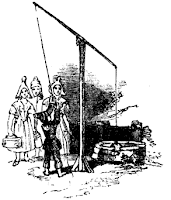
This 1865 article described the modern options to get water from a small well.
September talks are now up, and the first week's talks are below. As usual, there are some interesting talks this month, including a Medieval Feast Symposium.
"How many young persons know what a pump is, and are unacquainted with the manner by which water is raised by it from the earth. In early times wells were universally used, and water was drawn from them in buckets by the hand.
September talks are now up, and the first week's talks are below. As usual, there are some interesting talks this month, including a Medieval Feast Symposium.
"How many young persons know what a pump is, and are unacquainted with the manner by which water is raised by it from the earth. In early times wells were universally used, and water was drawn from them in buckets by the hand.
The
first improvement upon this was by means of a lever, as here represented, by
which the bucket is fastened to one end of the lever by a cord, while the
person wishing to raise the water hauls down the other end; but, as knowledge
advanced, a better method of raising water was discovered.
This better method is performed by the agency of a machine called a
pump, of which the larger engraving is a section. It is a hollow cylinder, with
a sort of bucket, as it is called by the plumber, in the upper part, to which a
rod is attached, and another towards the bottom, which is fixed. These buckets
are called more properly pistons, and the rod above the upper one the piston
rod. The upper piston is called the sucker or sucking piston, Both these
pistons are hollow, and each has a valve or lid at the top; when shut, these
valves fit close to the hollow of the piston, so as perfectly to shut out the
air; but they are fixed on hinges which move very easily, and give way to a
very light pressure: both open upwards towards the top of the pump. The lower
piston or plug is, as before stated, fixed, while the upper plug moves up and
down. When the barrel of the pump is empty, the space between the buckets is
filled with air; and when the upper bucket is forced down by the rod, the air
between the buckets will press down the lower valve of the bucket and shut it;
at the same time its upper pressure will open the valve of the upper bucket,
through which a portion of the air will escape. When this bucket begins to
ascend, the valve will fall and close the piston, and prevent the air entering the
pump from above. As it ascends, an empty space or vacuum will be left in the
pump, which the external air will endeavour to rush in to fill. As the lower
valve also opens upwards, it will yield to the pressure from below. The
pressure of the air, therefore, will force the water through the plug into the
barrel of the pump: at the next descent of the sucker the water will pass
through its valve into the upper chamber, and the next motion upwards will
carry it through the spout.
The Forcing Pump consists of two parts or barrels, - one similar to the
common pump, and the other rising by its side and connected to it near the
lower valve. The water is first raised in the former part in the same way as in
the common pump, excepting that the piston has no opening valve, but is solid,
and the air is forced out through the side valve into the adjoining tube or
barrel. Through this valve the water is also forced, and the pressure of the
descending piston makes it rise and enter the ascending tube and issue out at the
top. The length of the tube may be increased at pleasure."
Martin, William. The Holiday Book: with Numerous Illustrations ... 2d ed. London: 1865
THIS WEEK'S TALKS deleted
SYMPOSIUM
Se 6 Tue 4:30AM-12 The Great Medieval Feast, c.1050 - 1500 Symposium. University of Birmingham UK hybrid HERE, Program HERE
CALENDAR OF VIRTUAL FOOD HISTORY TALKS HERE
©2022 Patricia Bixler Reber
Researching Food History HOME






No comments:
Post a Comment